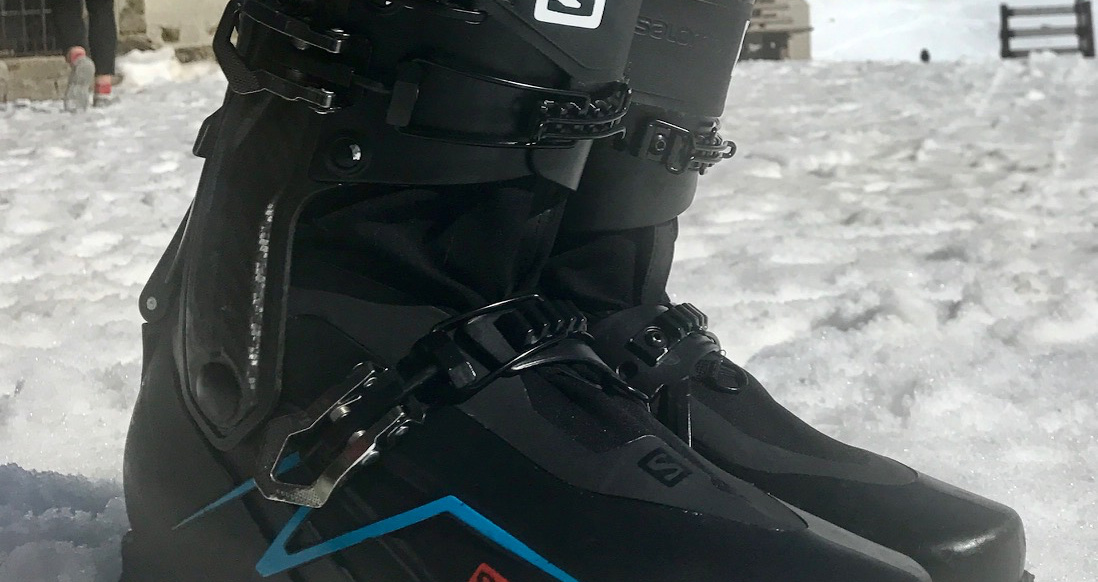Drew Daly, AMGA/IFMGA Mountain Guide
Intro
Last spring I was lucky enough to test this season’s Salomon S-Lab X-Alp ski touring boot. The S-Lab is Salomon’s addition to the lightweight touring and ski mountaineering market. In partnership with Arcteryx, they built off of their successful MTN Lab boot by trimming some fat and adding a revolutionary walk mode that allows significant lateral motion in the cuff.
Experience
I have put about 45 days on the boots in every condition imaginable: deep powder, smooth corn, bullet proof ice and breakable crust. I skied these boots on three separate pairs of skis with underfoot widths of 99mm, 104mm and 115mm. Most of the days I skied these boots was on the 104 K2 Coomback while guiding in the European Alps. In addition to skinning and skiing, I put in time boot packing, cramponing and rock scrambling.
Looks
Let’s start with the important stuff: these boots look bad ass! I call them my ninja shoes because of their low profile, jet black build. This simple design keeps these boots super lightweight.
Fit
I have a wide forefoot, skinny heel and high arch. I was worried about skiing this boot at first because it can be considered to have a low to medium volume fit, while normally I look for high volume boots. I normally ski a 27/27.5 shell size coming from Atomic and Scarpa boots. Luckily, I ended up with one shell size larger (28/28.5) than I normally wear. Out of the box these felt great, but like every ski boot I’ve owned in the past 10 years, I did some shell punching to accommodate my “6th toes” and “angry pinkys”. Due to the lack of forefoot buckles and soft plastic, punching was a piece of cake.
The S-Lab comes with heat moldable liners. As per normal, I replaced the liners with Intuition Pro Tour liners. After boot punching and liner molding, I can say these are as comfy as any ski boot I have owned, which is a rarity for me.
Walk Mode
The walk mode is the standout feature of this boot. Branded as a 3D rotating cuff, two separate, carbon cuff sections allow the ankle significant lateral motion to role to the inside or outside. It wasn’t until I arrived in Europe after a low snow year and very firm conditions that I realized how awesome this feature is. With any kind of firm skinning or booting this boot truly allows you to roll your ankles out in order to provide more surface area for you skins or crampon points. I was able to use ski crampons less and my ankles, knees and hips were happier in the end.
To lock the cuff into ski mode there is a lever on the back of the boot that flips down. This lever is high on the boot and requires you to pull the cuff of your ski pants to the top of the boot. When the lever is flipped down a cable engages a plastic support against the two carbon cuffs to lock them into place. This system is complicated when compared with most walk modes, but it allows for the lateral movement that makes walking in this boot so enjoyable. So far I have had zero issues with the mechanism but should it break, it would be difficult to fix in the field.
Gaiter
Another feature that stood out to me when I first put these boots on was the lack of a tongue. In place of the tongue is a built in gaiter that is molded to the shell and wraps around the liner under the buckles. So far this gaiter has held up to the abuse, but I could see it being a vulnerable part of the boot after a season or two.
Buckles
One word: simple. These standard ski boot buckles are adjustable and bomber. The instep buckle could be lower profile as I found it getting opened on occasion while boot packing or talus walking. This can be annoying, but if I tightened the buckle one notch while booting they would stay put.
Above the cuff buckle is a built in booster strap that is riveted to the two carbon cuff sections and allows them to rotate. This booster strap is bomber, but it cannot be upgraded or replaced easily.
Sole
Being lightweight and low profile, the sole performed excellently in all conditions including boot packing, talus walking and rock climbing. The standardized heel and toe welts provide good fit with a classic, bailed boot crampon.
Ski Mode
Now, for the million dollar question, how does it ski?! Let’s be honest, this is not an alpine boot or a freeride boot and it’s not supposed to be. Having recently skied the Scarpa Maestrale RS, Scarpa F1 and Atomic Backland, I think it skis similar to the F1 and the Backland. The biggest thing for me to get used to was the lack of a tongue. Initially it felt like there was nothing for my shin to push against, but after dialing in the fit I found enough support with the carbon cuff. The steep forward lean also took some getting used to as it puts you in a fairly aggressive stance, which has probably helped my skiing. It took about a week of skiing them to feel comfortable in all types of snow conditions and skiing at high speeds. In firm conditions, I felt like I could drive my 104 Coombacks just fine, but I wouldn’t want to go any wider or heavier unless I was skiing powder.
This boot is a unique addition the the lightweight touring market. It’s walkability is unmatched by any other booth I’ve skied. While I think this boot shines as a ski mountaineering boot, it is now my go to touring boot that I feel comfortable skiing anything and everything in.
